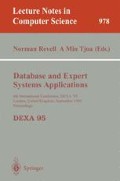Abstract
To develop an algorithm for any application takes thought and a lot of trial and error. The algorithm must be coded, compiled, tested for compliance with the specification. If it does not perform to target, the code must be amended, recompiled and tested again. The process is cyclic and time consuming. In this paper a novel method is introduced which allows the building or tuning of algorithms or programs at run-time by using an active database. The paper uses the domain of robotic vision as a case study to introduce the concept, particularly the first stage of the object recognition process known assegmentationi.e. extracting the primitive characteristics of the objects of interest. The system has been implemented upon the REFLEX active database system.
Preview
Unable to display preview. Download preview PDF.
References
Agrawal R. and Gehani N.H., “Rationale for the Design of Persistence and Query Processing Facilities in the Database Programming Language O++”, 2nd Int. Workshop on Database Programming Languages, Portland, OR, June 1989
Aleksander I., Thomas W.V. and Bowden P.A., “WISARD — A Radical Step Forward in Image Recognition”, Sensor Review. July 1984
Chakravarthy S., Blaustein B., Buchmann A., et al., “HiPAC: A Research Project in Active, Time-Constrained Database Management”, Final Technical Report, Xerox Advanced Information Technology Division, July 1989
De Haas L.J., “Automatic Programming of Machine Vision Systems”, Proceedings of the International Joint Conference on Artificial Intelligence, 1987
Diaz O., Paton N.W. and Gray P., “Rule Management in Object-Oriented Databases: A Uniform Approach”, Proc. of the 17th Int. Conf. on Very Large data Bases, Barcelona, Spain, 1991
Genesereth M.R. and Nilsson N.J., “Logical Foundation of Artificial Intelligence”, Los Altos, California: Morgan Kaufmann, 1987
Iwase H., Toriu T. and Gotoh T., “An Expert System for image processing”, Proceedings of the Fourth Conference on Artificial Intelligence Applications, San Diego, March 1988
Marr D., “Vision”, Freeman, San Francisco, 1982
McCarthy D.R. and Dayal U., “The Architecture of an Active Data Base Management System”, Proc. ACM SIGMOD Intl. Conf. on Management of Data, Portland, June 1989
Naqvi W. and Ibrahim M.T., “REFLEX Active Database Model: Application of Petri-Nets”, Proc. of the 4th Int. Conf. on Database and Expert Systems Applications, Prague, September 1993
Naqvi W. and Ibrahim M.T., “Rule and Knowledge Management in an Active Database System”, Proc. of 1st Int. Workshop. on Rules in Database Systems, Edinburgh, September 1993
Naqvi W. and Ibrahim M.T., “EECA: An Active Knowledge Model”, Proc. of the 5th Int. Conf. on Database and Expert Systems Applications, Athens, September 1994
Naqvi W. and Ibrahim M.T., “Active Distribution by Stealth”, Proc. of the 6th Int. Conf. on Database and Expert Systems Applications (workshop), London, September, 1995
Naqvi W., Panayiotou S., Soper A. and Ibrahim M.T, “Cortextual Parsing: The use of an active database to provide semi-evolving segmentation algorithms”, Tech. Report CIT-DSRL069301, University of Greenwich, June, 1993
“ONTOS Reference Manual”, ONTOS Inc, 1991
“POET 2.1 Programmer's & Reference Guide”, POET Software Corporation, 1994
Sadjadi F. and Nasr H., “A technique for automatic design of image segmentation algorithms”, Proceedings of the SPIE-The Int. Society for Optical Engineering, Vol: 1098 p. 177–81, 1989
Stonebraker M. and Kemnitz G., “The POSTGRES Next-Generation Database Management System”, CACM October 1991, Vol 34, No 10
Subbarao M., “Interpretation of Visual Motion: A Computational Study”, Morgan Kaufmann Publishers, 1988
Wilensky, “Planning and Understanding”, Reading, Addison Wesley, 1983
Lohman G. M., Lindsay B., Pirahesh H. and Schiefer K. B., “Extensions To STARBURST: Objects, Types, Functions, and Rules”, CACM October 1991, Vol 34, No 10
Author information
Authors and Affiliations
Editor information
Rights and permissions
Copyright information
© 1995 Springer-Verlag Berlin Heidelberg
About this paper
Cite this paper
Naqvi, W., Panyiotou, S. (1995). Applied active databases for evolving image processing algorithms. In: Revell, N., Tjoa, A.M. (eds) Database and Expert Systems Applications. DEXA 1995. Lecture Notes in Computer Science, vol 978. Springer, Berlin, Heidelberg. https://doi.org/10.1007/BFb0049118
Download citation
DOI: https://doi.org/10.1007/BFb0049118
Published:
Publisher Name: Springer, Berlin, Heidelberg
Print ISBN: 978-3-540-60303-0
Online ISBN: 978-3-540-44790-0
eBook Packages: Springer Book Archive

